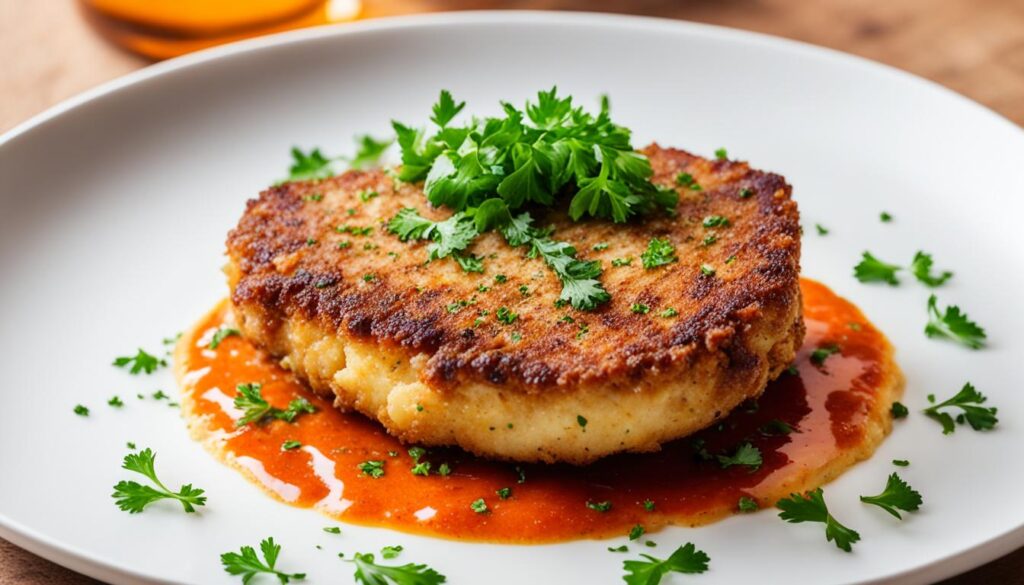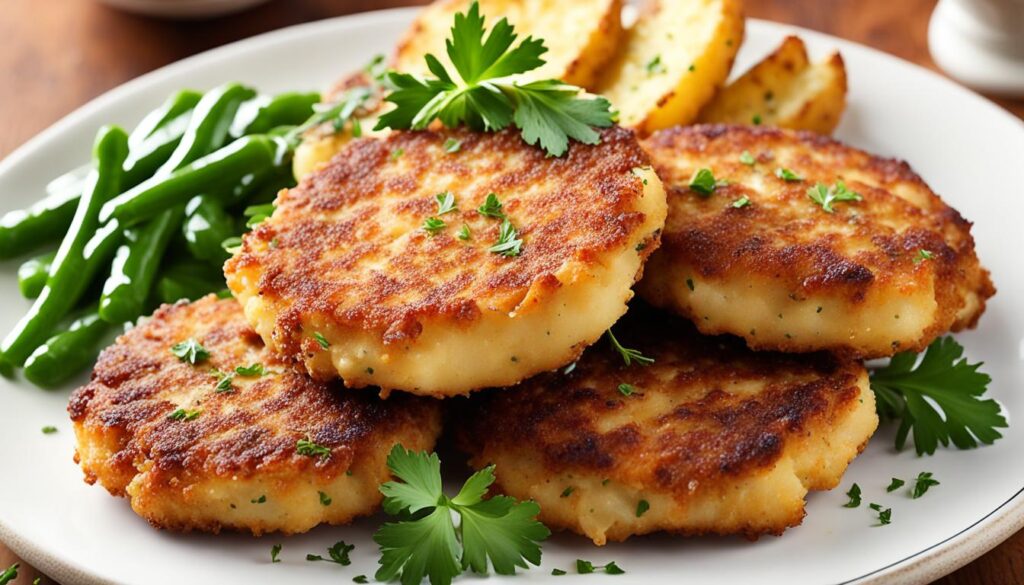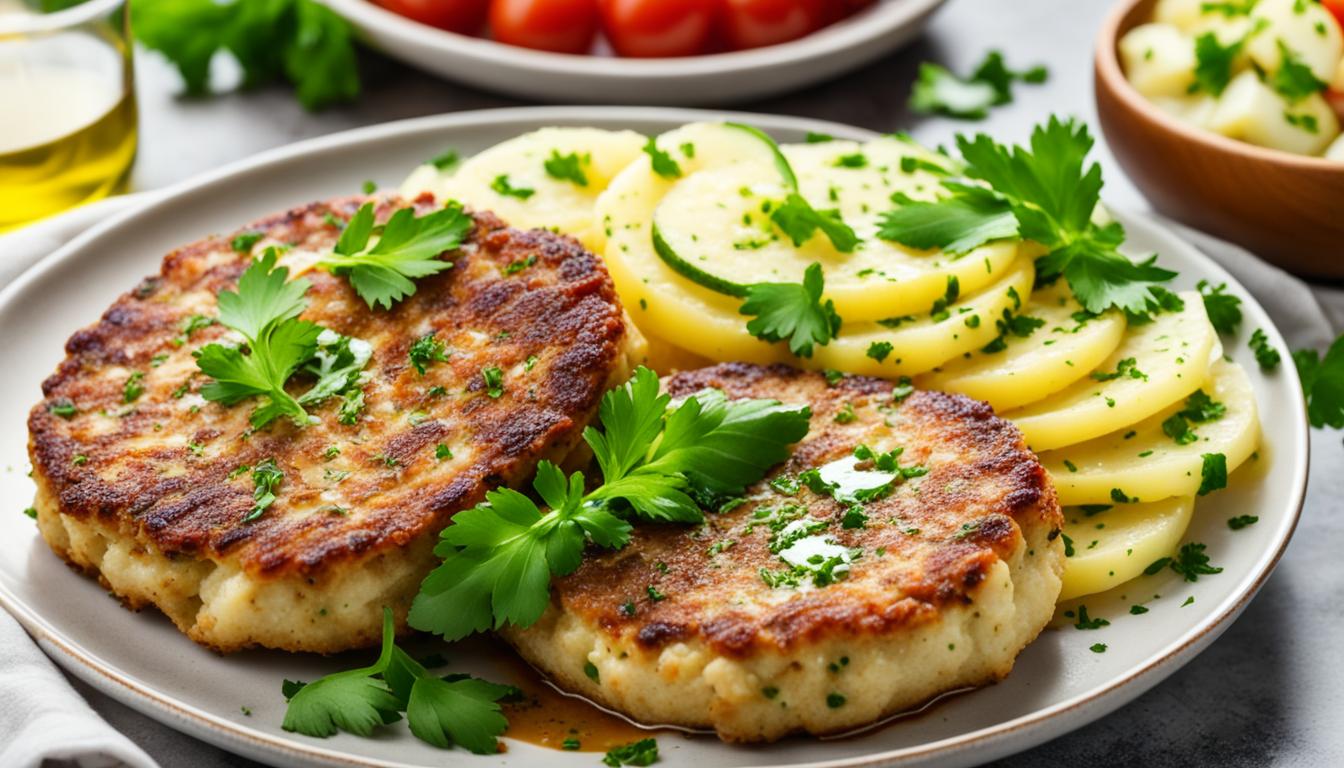Are you ready to embark on a culinary journey to Iran and savor the rich flavors of Persian cuisine? Imagine biting into a crispy and savory meat and potato patty, perfectly seasoned with aromatic spices. The combination of tender ground meat and mashed potatoes creates a mouthwatering delight that is loved across Iran and the Persian diaspora. But what is the secret behind the authentic Persian kotlet recipe? Let’s uncover the culinary traditions and techniques that make this dish truly special.
Key Takeaways:
- Discover the unique blend of flavors and textures in authentic Persian kotlet.
- Learn about the essential ingredients and proper preparation techniques.
- Explore tips and tricks to achieve the perfect crispy kotlet.
- Understand the potato selection and preparation process.
- Explore variations and serving suggestions for this versatile dish.
Ingredients and Preparation
In order to make the perfect traditional Persian kotlet, you will need the following key ingredients:
- Ground beef or lamb
- Potatoes
- Eggs
- Spices (such as turmeric and black pepper)
- Flour for coating the patties
The first step in preparing the kotlet is to boil and mash the potatoes. This can be done by peeling the potatoes, cutting them into chunks, and boiling them until they are soft and easily mashed. Once boiled, drain the potatoes and use a potato masher or fork to mash them until smooth.
Next, mix the mashed potatoes with the ground meat, eggs, and spices. The spices, such as turmeric and black pepper, can be adjusted according to your taste preference. Mix all the ingredients together until well combined.
Pro tip: For an extra burst of flavor, you can also add finely chopped onions, garlic, or fresh herbs such as parsley or cilantro to the mixture.
Forming the Patties
Once the mixture is well combined, it’s time to form the patties. Take a portion of the mixture and shape it into a round or oval patty, about 1/2 inch thick. Repeat this process until all the mixture has been shaped into patties.
To ensure a crispy exterior, lightly coat each patty with flour. This will help in browning the patties and prevent them from sticking to the pan during cooking.
Pan-Frying the Kotlet
In a large skillet or frying pan, heat oil over medium heat. Once the oil is hot, carefully place the patties in the pan, leaving some space in between for easy flipping.
Cook the kotlet for about 4-5 minutes on each side, or until they are crispy and golden brown. Make sure to flip them gently to avoid breaking the patties. Once cooked, remove the kotlet from the pan and transfer them onto a paper towel-lined plate to absorb any excess oil.
Your crispy and delicious Persian kotlet is now ready to be served!
“The combination of tender potatoes and flavorful ground meat, pan-fried to perfection, creates a delightful crispy kotlet that will leave your taste buds craving for more.”
Now that you know the secret to making traditional Persian kotlet, go ahead and impress your friends and family with this delicious dish!
| Ingredient | Quantity |
|---|---|
| Ground beef or lamb | 1 pound |
| Potatoes | 4 medium-sized |
| Eggs | 2 |
| Spices (turmeric, black pepper) | To taste |
| Flour | For coating |
Cooking Tips and Techniques
When it comes to preparing the perfect kotlet, following these cooking tips and techniques will ensure outstanding results. Whether you’re a seasoned cook or a beginner, these suggestions will help you create a kotlet masterpiece.
- Dimple the patties: Before pan-frying the kotlet, make sure to dimple the patties. This process prevents the patties from ballooning and ensures even cooking. Dimpling creates a uniform surface, resulting in a perfectly cooked kotlet.
- Lightly dust with flour: Just before frying, lightly dust each kotlet patty with flour. This simple step enhances the browning process, giving your kotlet a delightful crispy exterior. The flour forms a thin layer that adds an extra layer of texture and flavor.
- Shake the pan: While pan-frying the kotlet, gently shake the pan from time to time. This motion helps distributed the oil uniformly, ensuring an even cooking process. It also prevents the kotlet from sticking to the pan, resulting in a perfectly golden-brown crust.
“Remember, dimpling the patties and dusting them with flour are essential techniques for achieving a well-cooked crunchy kotlet. And don’t forget to give the pan a gentle shake to ensure even cooking!”
These tips will guide you in cooking the best kotlet, but serving it authentically is equally important. Kotlet is traditionally enjoyed with crispy potatoes, fresh tomatoes, pickles, yogurt, and flatbread. This combination of flavors and textures complements the kotlet perfectly, offering a truly authentic Persian experience.
Crispy Kotlet Serving Suggestions:
- Crunchy Pan-Fried Potatoes
- Freshly Sliced Tomatoes
- Tangy Cucumber Pickles
- Rich and Creamy Yogurt
- Warm and Fluffy Flatbread
By incorporating these serving suggestions, you’ll enjoy a complete and satisfying kotlet meal that represents the true essence of Persian cuisine.

Potato Selection and Preparation
In order to create the perfect kotlet, it is essential to select and prepare the potatoes correctly. While there are specific potato varieties commonly used in Iran for making kotlet, such as Pashandi and Estānboli, you can also use other readily available potatoes like russet, Yukon Gold, and red potatoes.
To ensure the best texture and flavor in your kotlet, follow these steps for potato selection and preparation:
- Peel and Cut: Start by peeling the potatoes and cutting them into small chunks. This will help them cook evenly and ensure smooth texture in the patties.
- Boil: Place the potato chunks in a pot and cover them with water. Bring the water to a boil and cook the potatoes until they are fork-tender. This usually takes around 15-20 minutes.
- Mash: Once the potatoes are cooked, drain the water and transfer them to a mixing bowl. Mash the potatoes using a potato masher or a fork until they are smooth and free of lumps.
To achieve the best texture in your kotlet, we recommend using a ricer or a food mill to mash the potatoes. This will ensure a finer consistency and help the mixture bind together well.
| Potato Variety | Texture | Suitability |
|---|---|---|
| Pashandi | High-starch, similar to russets | Preferred for authentic taste |
| Estānboli | Low-starch, yellow potato | Traditional choice |
| Russet | High-starch | Commonly available |
| Yukon Gold | Medium-starch | Works well in kotlet |
| Red potatoes | Low-starch | Suitable for kotlet |
By following these steps and selecting the appropriate potatoes, you can ensure that your kotlet has the perfect texture and authenticity that is characteristic of this traditional Persian dish.
Meat Selection and Variation
When it comes to making delicious kotlet, the choice of meat plays a crucial role in creating the perfect flavor and texture. In Persian cuisine, both ground lamb and beef are commonly used to make kotlet, with each option bringing its own unique characteristics to the dish.
Lamb: Lamb is the traditional meat of choice for kotlet in Persian cuisine. Its tender and succulent qualities add a rich and distinctive flavor to the patties. Lamb kotlet is highly favored for its unique taste and is often considered the epitome of authenticity when it comes to Persian food.
Beef: While lamb is the traditional option, beef is equally popular and widely enjoyed in kotlet. Ground beef provides a heartier and slightly milder flavor compared to lamb. It is an excellent alternative for those who prefer a different taste or have dietary preferences. Beef kotlet is just as delicious and satisfying, making it a suitable choice for any kotlet enthusiast.
Variation: The choice of meat in kotlet can vary according to personal preferences and regional traditions. Some recipes call for a combination of lamb and beef, resulting in a unique blend of flavors. On the other hand, some recipes rely solely on one type of meat. Whether you choose lamb, beef, or a combination of both, the choice is ultimately up to you and your taste preferences.
| Meat | Characteristics |
|---|---|
| Lamb | Tender, succulent, and rich in flavor |
| Beef | Hearty, milder flavor, suitable for different preferences |
| Variation | Combination of lamb and beef for a unique blend of flavors |
No matter which type of meat you choose, it’s important to ensure that the meat constitutes less than 50 percent of the kotlet’s total ingredients by weight. This not only promotes a healthier balance but also allows the other elements, such as the mashed potatoes and spices, to shine through and create a well-rounded and flavorful kotlet.

With your choice of meat selected, you’re well on your way to creating an authentic and delicious kotlet using our traditional Persian kotlet recipe. The combination of ground meat, finely mashed potatoes, and aromatic spices will result in mouthwatering patties that are sure to impress your family and friends.
Traditional Serving Suggestions
Kotlet is a versatile dish that can be enjoyed in various ways, whether served hot or cold. As a main dish, it is commonly served hot with crispy potatoes, sliced fresh tomatoes, salty cucumber pickles, yogurt, and flatbread, creating a satisfying and well-balanced meal.

For a traditional Persian dining experience, kotlet can also be served as an accompaniment to Persian steamed white rice or rice dishes known as polows. The combination of kotlet with the fragrant and flavorful Persian rice adds depth and richness to the meal.
Furthermore, kotlet is a popular snack that is perfect for lunchboxes or picnics. Its compact size and portability make it an ideal option for on-the-go meals. Kotlet can be enjoyed on its own as a quick snack or used as a filling for sandwiches with different types of flatbread. Its versatility allows you to experiment with various fillings and condiments, creating a personalized and delicious sandwich experience.
Cold Kotlet and Leftover Ideas
When it comes to kotlet, the deliciousness doesn’t end with just hot, fresh patties. Cold kotlet is a popular snack at home, perfect for a quick bite or packed lunches. In Persian cuisine, it is often enjoyed alongside Persian flatbread or other types of bread.
Leftover kotlet can be just as tasty, and there are several creative ways to enjoy them. One option is to reheat the patties in a toaster oven to retain their crispness and savor the familiar flavors. Alternatively, cold kotlet can be eaten as is straight from the refrigerator, maintaining their unique texture.
In addition, leftover kotlet can be the star ingredient in traditional Persian sandwiches. Take a soft bread roll and layer it with butter, mustard, fresh herbs, onion slices, juicy tomatoes, and tangy pickles. Then, insert the cold kotlet into the roll and experience the delightful combination of flavors and textures.
Looking to add a visual appeal to the blog post? Consider inserting an image to showcase the mouthwatering cold kotlet or the appetizing sandwich creation.
Variations and Additions for Cold Kotlet and Sandwiches
| Variation/Addition | Description |
|---|---|
| Avocado Slices | Adding rich, creamy avocado slices brings a fresh and indulgent twist to the sandwich. |
| Crunchy Lettuce | Adding crisp lettuce leaves provides a refreshing crunch and enhances the overall texture. |
| Sriracha Mayo | Drizzling sriracha mayo over the cold kotlet brings a spicy kick and a creamy element to the sandwich. |
| Fried Egg | For an extra protein boost, top the sandwich with a perfectly fried egg with a soft center. |
Get creative with your cold kotlet and sandwiches by experimenting with different variations and additions. From tangy pickles to spicy sauces, the possibilities are endless. Let your taste buds guide you in creating your perfect combination.
Vegetarian Twist on Kotlet
While traditional kotlet is made with ground meat, there is a vegetarian version that satisfies your cravings without the meat. This vegetarian twist brings together the flavors and textures that make kotlet so beloved in Persian cuisine, delivering crispy and flavorful patties that are sure to impress.
To create the vegetarian kotlet, we substitute the meat with nutrient-rich chickpeas. The mashed chickpeas are combined with boiled potatoes, onions, a blend of aromatic spices, and a generous handful of fresh herbs. This mixture is then shaped into patties and fried until golden and crunchy on the outside. The result is a mouthwatering vegetarian alternative that captures the essence of kotlet.
This vegetarian kotlet recipe is a great option for vegetarians or anyone looking to explore new flavors and variations of Persian cuisine. Not only does it offer a delicious way to enjoy kotlet, but it also provides a fantastic source of plant-based protein and essential nutrients from the chickpeas and other ingredients.
Taste the Authentic Flavors
The vegetarian kotlet maintains the signature flavors of traditional kotlet while offering a unique twist. The combination of mashed chickpeas, potatoes, and aromatic spices creates a patty that is rich in flavor and satisfyingly crispy on the outside. The fresh herbs add a burst of freshness and elevate the taste to new heights.
“The vegetarian kotlet is a culinary adventure that captures the essence of Persian cuisine while showcasing the versatility of plant-based ingredients.”
This vegetarian version of kotlet provides a delightful alternative to the meat-based version, offering a new way to enjoy the flavors of Persian cuisine. Whether you’re a vegetarian or simply seeking to expand your culinary horizons, this recipe is sure to impress.
Create your own Vegetarian Kotlet
| Ingredients | Instructions |
|---|---|
|
|
With this vegetarian kotlet recipe, you can experience the delicious flavors of Persian cuisine in a meat-free and satisfying way. Enjoy the crispy exterior, the aromatic spices, and the rich flavors of these vegetarian patties. Serve them as an appetizer, a side dish, or even as the star of a vegetarian meal.
Conclusion
Kotlet, a beloved dish in Persian cuisine, is known for its crispy exterior and soft, flavorful interior. Whether made with ground meat or vegetarian ingredients, kotlet offers a delicious and versatile option for meals and snacks. By following the authentic Persian kotlet recipe shared in this article, you can recreate the traditional flavors at home and enjoy the satisfaction of making this classic dish.
Experimenting with different variations and serving suggestions allows you to discover your favorite way to enjoy kotlet. Serve it hot with crispy potatoes, fresh tomatoes, pickles, yogurt, and flatbread for a traditional Persian meal. Alternatively, pair kotlet with steamed white rice or include it in sandwiches for a flavorful twist.
With kotlet, you can explore the rich flavors of Persian cuisine and experience the delight of sharing a traditional meal with family and friends. So gather your ingredients, follow the recipe, and savor the taste of the best kotlet you’ve ever made – a true showcase of Persian culinary excellence.
